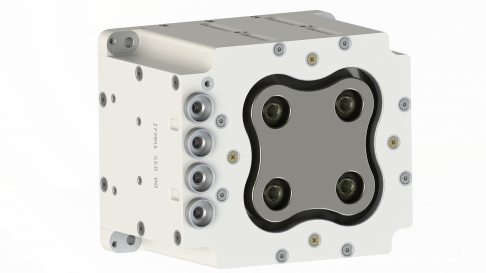-
StatusOngoing
-
Status date2020-02-17
-
Activity Code4B.155
The IFM Micro 100 Thruster is a 100W class thruster that can be clustered to higher thrust levels. It is an externally mounted thruster intended for orbit raising and station keeping of Small-Satellites including high LEO communication satellites, or station keeping, attitude control and momentum dumping of large Satellites. The Power Processing Unit required for the thruster can be either mounted directly below the IFM Micro 100 Thruster in a stacked configuration or can be separated and placed inside the spacecraft using a harness. The IFM Micro 100 Thruster is a metal based FEEP thruster using a passive flow management system, and therefore does not require pressure vessels. Due to the nature of the propellant, no moving parts are required, and the thruster is in an entirely inert, no-pressurized state during integration, testing and launch.

The trade-off in terms of power was performed based on updated customer requirements regarding platform constraints.
The trade-off between propellant reservoir size, number of ion emitter and power was based on the parameters of customer input requirements, volume allocation, structural stability and total crown emitter throughput capability.
The trade-off for the extractor high voltage design is based on the requirement of high thrust, low Isp operation point which requires increased high voltage potentials to be applied to the extractor electrodes. The major trade-off is based on high voltage insulation considerations, structural stability, emitter-extractor electric field shaping and design heritage.
With an input power of 100 W it produces up to 1.5 mN of thrust and 50 kNs of total impulse, which makes it particularly adapted to small and medium size spacecraft. The modular design of the IFM Micro 100 allows customers to cluster the thruster together to bigger units like a cluster of 6 with up to 9 mN thrust and 300 kNs total impulse.
It can be launched on any rocket or even deployed from the ISS as it contains no pressure vessels or energetic/toxic chemical. The thruster and propellant are all contained in a 14x12x10 cm module bolted directly to any flat panel. No accommodation for a separate tank or fluid piping is required.
The IFM Micro 100 is inherently redundant with more than a 100 parallel ion emission sites and 4 cold redundant neutralizers.
Its high specific impulse and the unrivalled control precision are perfect for station keeping and attitude control. End-of-life operations can be performed at the most optimal operation point depending on remaining propellant quantities.
- The IFM Micro Thruster is based around the flight proven and endurance tested ion emitter developed for the IFM Nano Thruster. It has been demonstrated to not suffer performance degradation over more than 10,000 hours of firing.
- The IFM Micro thruster allow for seamless transition between high thrust and high specific impulse modes by simple command over telemetry. As a result its firing point can be adapted for all mission phases, from high thrust orbit raising to high efficiency stationkeeping. It also allow for significant propellant margins for end of life disposal of the spacecraft.
- The IFM Micro Thruster is conceived to achieve thermal stability with negligible interface heat flux to the spacecraft. This is achieved through the unique benefit of the FEEP ionization process as well as a careful thermal design.
Design and Modelling of IFM Micro 100 Thruster: The detailed design of the IFM Micro 100 Thruster is conducted regarding function, thermal, structural and operational constraints to meet customer requirements. The design effort is supported by prototypes and engineering model testing.
Optimization of mass efficiency for low Isp operation: The goal is to evaluate the influence of manufacturing on the liquid Indium based Field Emission Electric Propulsion (FEEP) porous tungsten crown emitter performance. The focus is laid on the mass efficiency optimization of the ion emitters.
High Performance Emitter Manufacturing: Manufacturing technologies to improve the quality of emitters as well as improve the manufacturing performance of FEEP production are investigated and tested in this effort. This effort includes systematic characterization of manufacturing effects during production.
Improvement of Manufacturing Line: Improving the ENPULSION manufacturing line by incorporating the requirements received from customers regarding processes, documentation and PA requirements. Efforts undertaken comprise of the qualification of the processes for manufacturing indium emitters and the IFM Micro 100 Thruster.
The design, supported by modelling, will lead to passing a review validating the design changes. The high-performance emitter manufacturing work package be conducted in parallel and be concluded by a review showing the different leads pursued and results obtained.
After CDR, as the IFM Micro Thruster enters qualification and industrialization the manufacturing line improvement work package will be started. The mass efficiency optimization work is scheduled to happen independently as it is not expected to lead to major manufacturing or design changes. This work package will be close with the manufacturing line improvement at the end of the project.
- The IFM Micro 100 Thruster has completed CDR, incorporating the changed architecture. This design effort was supported through modelling.
- Engineering model of the IFM Micro 100 Thruster has been tested in relevant environment.
- Several changes have been implemented in the production line of the IFM thrusters as part of a continuous improvement effort in raising quality and yield of produced emitters.
- Mass efficiency optimization efforts are currently starting




